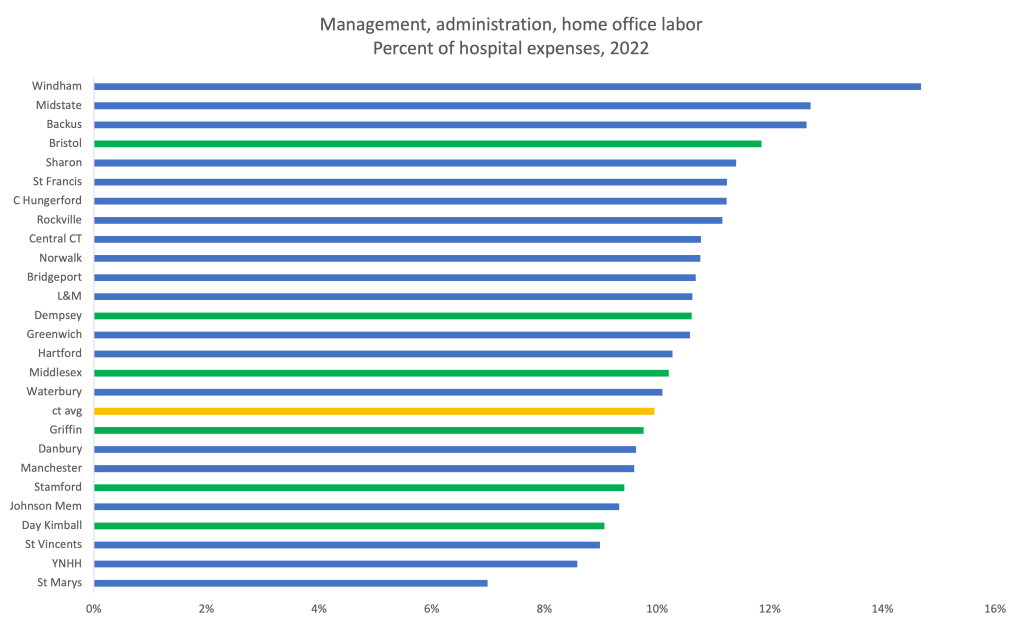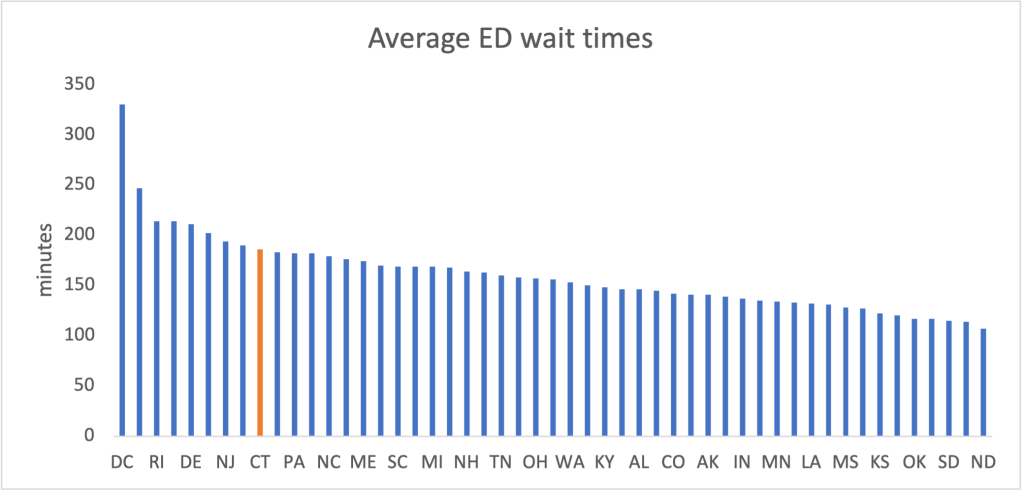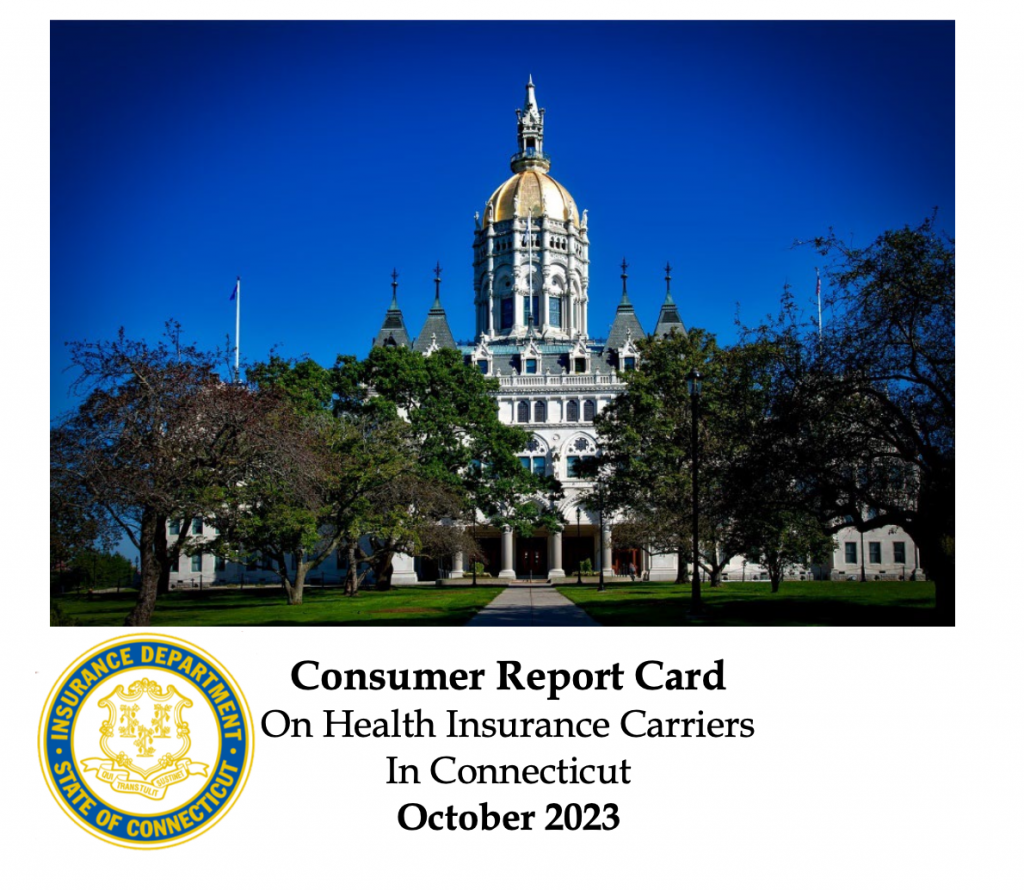Health Report Card
US News: CT is 3rd best in US for healthcare
Based on surveys of state residents on their priorities for state government and health data, Connecticut is third best among states for healthcare, our highest ranking among categories. Healthcare was equally weighted between access (#3 among states), quality (#21), and public health (#6). The subtopics for each health category are: Access Quality Public health Adults…
Read MoreFrom 2011 to 2022, CT hospital budgets devoted 12% to administration labor and 30% to direct patient care labor
Download the brief Download the data Parsing the latest data from NASHP’s Hospital Cost Tool finds that in 2022, Connecticut’s acute care hospitals averaged almost 32% of their budgets on direct patient care labor and just under 12% on labor costs for administration, which includes management, administration, and payments to their larger health system (called…
Read MoreBook Club: Recoding America – Why Government is Failing in the Digital Age and How We Can Do Better
If you’ve ever muttered under your breath about the inefficiency/waste/frustration/etc of government at all levels, you have to read Recoding America – Why Government is Failing in the Digital Age and How We Can Do Better, by Jennifer Pahlka. I don’t think I’ve ever dogeared as many pages in a book. While the author explores…
Read MoreAnalysis: What to do about private equity in healthcare?
The news is full of Prospect Medical Holdings, a private-equity fund, laying waste to three Connecticut hospitals. State policymakers are looking to create guardrails so that this doesn’t happen again. But we were warned two years ago and policymakers didn’t act. Read more
Read MoreWebinar offers tools to improve prescribing
Download the slides and watch the webinar recording Connecticut, like other states, are struggling to improve appropriate prescribing while lowering costs. In Friday’s webinar, Greg Low, RPh, PhD, offered Mass General’s experience of what works to improve physician prescribing at their ACO. Greg is the Manager for Pharmacy Operations at Mass General Brigham Health Plan.…
Read MoreCT ranks ninth worst in ED wait times
A new analysis by Becker’s Hospital Review of CMS data finds that patients wait an average of 186 minutes to be seen in a Connecticut emergency room. The national median was 162 minutes. The study covered April 2022 through March 2023. Connecticut hospitals varied considerably in average wait times from 98 minutes at Lawrence &…
Read MoreCT again among healthiest states overall, but with big areas of concern
Connecticut ranked 4th healthiest among states in this year’s America’s Health Ranking, from the United Health Foundation. We were the best state in climate policies, childhood immunizations, and adult dental visits. But we were in the bottom on other indicators. Connecticut is in a very healthy region of the US, with New Hampshire (#1), Massachusetts…
Read MoreICER seeking nominations for New England evidence review council
The Institute for Economic and Clinical Review (ICER) is seeking nominations for new members to the New England Comparative Effectiveness Public Advisory Council (New England CEPAC). In my time on the New England CEPAC, it was an exciting dive into learning new things with a team of exceptional experts and colleagues from across the region.…
Read MoreCT commercial insurance enrollment down 5%; several possible explanations
Download the report Last year, total enrollment in Connecticut’s commercial managed care plans was 1,666,972. That was down by 85,019 from 2021 at 1,750,904, according to the this year’s Consumer Report Card from the CT Insurance Department. The drop in enrollment was almost entirely from large group plans with over 50 members and spread across…
Read MoreNew data finds CT obesity rates grew by 25% from 2011 to 2022
Download the brief New data from the CDC finds that three in ten Connecticut adults (30.6%) were obese last year, up from one in four (24.5%) in 2011. While too high, Connecticut’s rate was 10th lowest among the states. The US average last year was 33.6%, up 21% from 2011. Connecticut’s rate was typical of…
Read More








